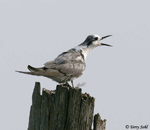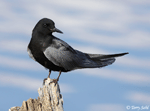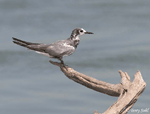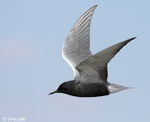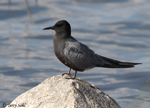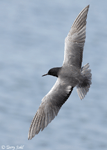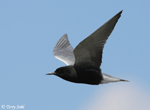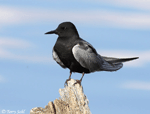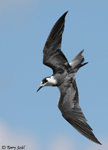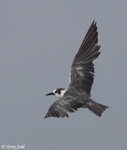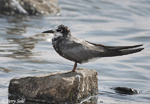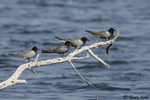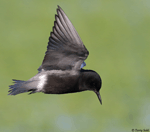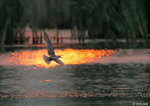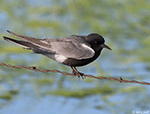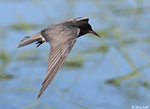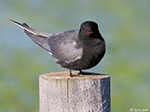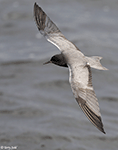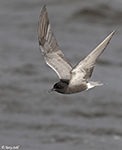| Length: 9 to 10 inches | Wingspan: 20 to 24 inches | Seasonality: Summer / Migrant |
| ID Keys: Distinctive, head and body mostly black, wings and tail gray. dark red legs and feet | ||
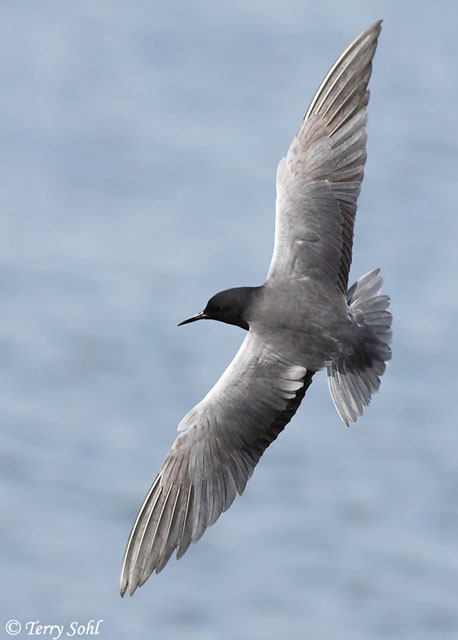 A black bodied tern that
is easily identifiable in South Dakota, especially in its dark breeding
plumage. The bird at the right is an adult, breeding plumaged bird, with a
black body and silvery-gray wings. Non-breeding birds are much lighter in
coloration, with white underparts and head, gray wings, and a small amount of
black on the back of the head. Black Terns lead a unique life, nesting on
freshwater marshes in the interior of North America, while wintering at sea
around South America. They gracefully pluck food items in flight from the
surface of the water. They will also chase flying insects, doing much of
their foraging over aquatic habitats, but they will also forage over nearby
terrestrial habitats. As with some other gull and tern species, they will
sometimes follow farm equipment to pursue insects that are stirred up.
A black bodied tern that
is easily identifiable in South Dakota, especially in its dark breeding
plumage. The bird at the right is an adult, breeding plumaged bird, with a
black body and silvery-gray wings. Non-breeding birds are much lighter in
coloration, with white underparts and head, gray wings, and a small amount of
black on the back of the head. Black Terns lead a unique life, nesting on
freshwater marshes in the interior of North America, while wintering at sea
around South America. They gracefully pluck food items in flight from the
surface of the water. They will also chase flying insects, doing much of
their foraging over aquatic habitats, but they will also forage over nearby
terrestrial habitats. As with some other gull and tern species, they will
sometimes follow farm equipment to pursue insects that are stirred up.
Habitat:
Marshes, ponds, lakes, flooded fields
Diet:
Mostly insects and fish, also frogs and tadpoles, earthworms, and crustaceans.
Behavior:
Forages while in flight, dipping down to the water's surface to grab food, or also by catching insects in mid-air.
Nesting:
June. They breed in small colonies, sometimes associated with other species such as the Forster's Tern. The nest is a mound of wetland vegetation with a slight depression on the top. The female lays between 2 and 4 eggs, and both parents help to incubate them. When the eggs hatch, both parents help tend to the yong. The young fledge as soon as 3 weeks after hatching, but parents typically feed the young for another few weeks after fledging.
Interactive eBird Map:
Click to access an interactive eBird map of Black Tern sightings
Song:
The most commonly heard vocalization is a repetative keek-keek-keek.
Migration:
Summers in much of the northern Great Plains, the Great Lakes, and western U.S., as well as southern Canada. Winters along northern coasts of South America.
Similar Species:
Generally distinctive compared to other tern species in North America. Very similar to the White-winged Tern, a Eurasian species that is a rare vagrant to North America.
South Dakota "HotSpot":
Black Terns are not particularly difficult to find in the eastern part of the state. They usually start arriving in early- to mid-May, and and migrating birds can be found into September. The wetland habitats of the Prairie Pothole region in eastern South Dakota are great locations to look. The area around Lake Thompson in Kingsbury County and the Highway 81 lakes north of Madison have always been good places to find Black Terns during the right time of year.
Conservation Status:
Populations have declined sharply in the past 40 years, likely due to drainage of wetlands required for nesting. Farm chemical runoff is another possible reason. Despite population declines, they are still found over a wide geographic area, and are common in some areas. The IUCN lists the Black Tern as a species of "Least Concern".
Further Information:
- USGS Patuxent Bird Identification InfoCenter, Black Tern
- BirdWeb - Black Tern
- Audubon Guide - Black Tern
Photo Information:
May 14th, 2010 - Lake Whitewood in South Dakota -- Terry Sohl
Additional Photos:
Click on the image chips or text links below for additional, higher-resolution Black Tern photos.
Audio File Credits:
- 1Ad Postma. Recorded in the Netherlands on June 18th, 2018. Original recording and information available from xeno-canto.
- 2Isain Contreras Rodriguez. Recorded in Sinaloa, Mexico on June 19th, 2020. Original recording and information available from xeno-canto.
| Click on the map below for a higher-resolution view |
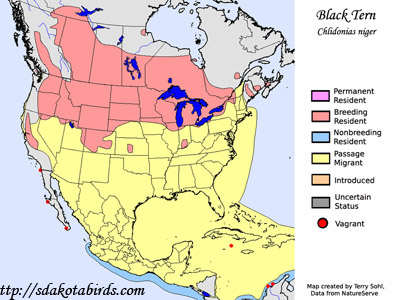 |
| South Dakota Status: Common summer resident in the eastern part of the state, uncommon in the west. |
Additional Black Tern Photos
Click for a higher-resolution version of these photos
